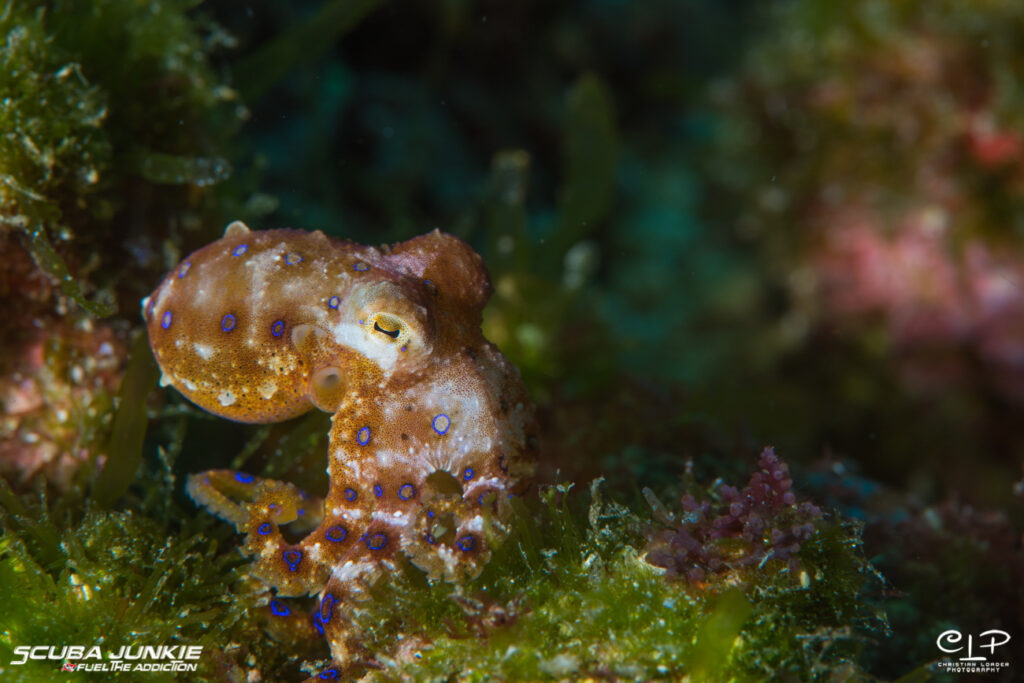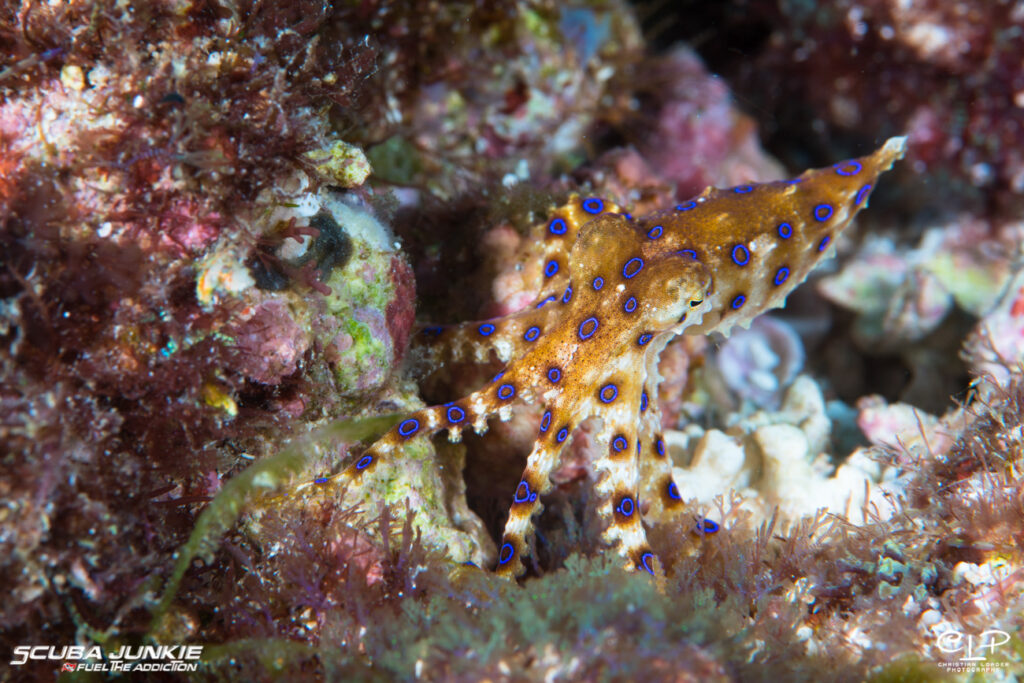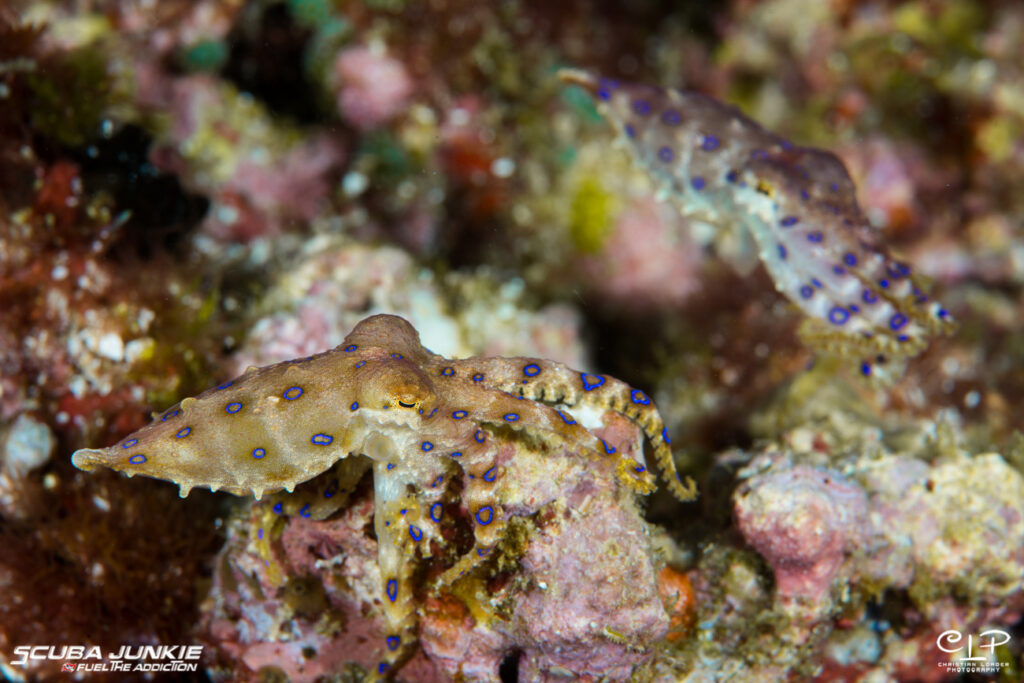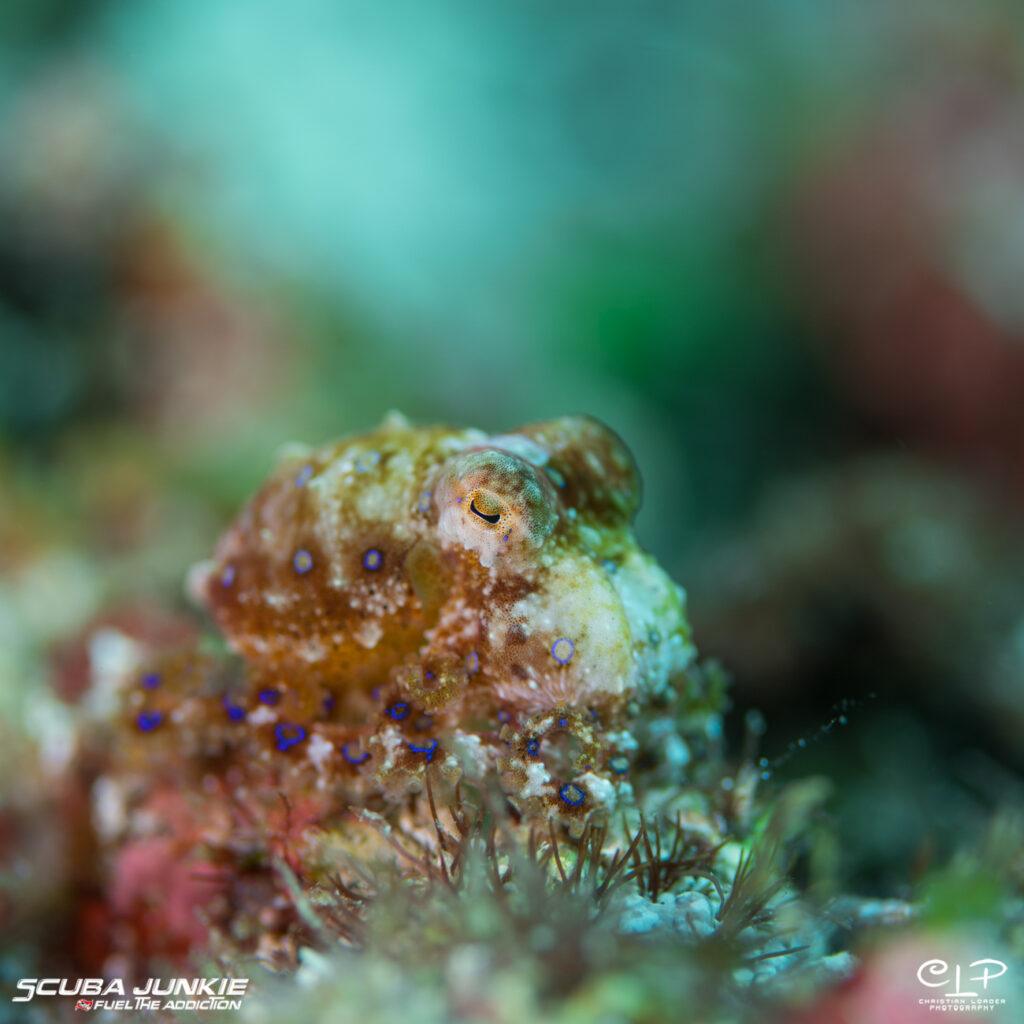Menu

The Blue Ring Octopus is on almost every diver’s bucket list and if it isn’t on yours it should be!!
This small octopus is without doubt a stunning creature to see and many divers choose to go to special places just to see them. So let’s dive in and learn a little more about these incredible animals!

Blue Ring Octopus are part of the genus; Hapalochlaena and actually refer to a group of species rather than a single one.
They are part of the Class Cephalopodea. The name Cephalopod comes from the Greek words ‘kephalos’ for head and ‘podos’ for foot. They that get their name because their limbs are attached to their head!
These small octopus get their name from the iridescent blue rings that cover their body. When they feel under threat these blue rings flash to ward off predators. These blue rings are an example of aposematism, where animals use bright colours to warn off other animals / predators, but unlike other animals that posess this method of defence the rings of the Blue Ring Octopus only light up & flash when they feel under threat. The remainder of the time they are still visible, but just barely. (If you can get close enough for a look!)

Blue Ring Octopus have been found in the Pacific and Indian Oceans and tend to inhabit rocky or algae areas so are most commonly found on dive sites that we would class as muck-diving or macro sites. Here in Komodo we tend to see Blue Rings on the dive sites of Karang Makassar (or Manta Point), Gindang & Waenilu, but we have also spotted them at Batu Bolong and Shark Point!
Blue Ring Octopus are small so it really does take a keen eye to spot them. They tend to be nocturnal in nature often coming out at night to hunt. They spend a lot of time tucked under algae, or hiding under crevices to avoid being seen by potential predators.
Did you know there is more than just one Blue Ring Octopus?! There is thought to be 10 different species of Blue Ring Octopus, but only 4 have been named.
The Greater Blue-Ringed Octopus (Hapalochlaena Lunulata)
This is the one we see here in Komodo. It is found, not only here in Indonesia but also, in the Philippines, Vanuatu, Solomon Islands and Papua New Guinea. It tends to prefer the shallows can is found up to about 20m deep.
The Southern Blue-Ringed Octopus (Hapalochlaena Maculosa)
This Blue Ring lives in water up to 50 m deep. They have only been seen along the Southern coast of Australia and Tasmania. This Blue Ring is much bigger than the Greater Blue-Ringed Octopus (even though the name would suggest otherwise) as it can be about 22cm long (including the legs). The Greater Blue-Ringed Octopus is about 12cm.
The Blue-Lined Octopus (Hapalochlaena Fasciata)
This one is a little different as it has iridescent lines alone it’s mantle (the back of the head that gives it the octopus shape), but it still has the classic blue rings on its limbs. This octopus is found in Eastern Australia and is about 15cm long.
Hapalochlaena Nierstraszi (No common name)
This species of Blue Ring has only ever been recorded twice. The first time in 1938 in the Andaman Islands and then a second time in 2013 in Southeast India. There is very little know about it.
As I have said this animal gets its name from the iridescent blue rings on its body. These beautifully vibrant rings are not just for show. They are a warning. If the warning is not heeded the Blue Ring Octopus can release tetrodotoxin (TTX) from its salivary glands. TTX is neurotoxic & blocks the transmission of nerve impulses. This stops muscles being able to contract and can have a deadly outcome for the victim. Paralysis will occur as the toxin takes affect and death is due to respiratory failure as the muscles fail to work. This can occur in just a few minutes of exposure.
Some studies state that TTX is 1000 times more toxic than cyanide. Blue Rings can inject this into their victims through a bite. There is no known antidote for TTX.
Thankfully incidents of humans being bitten by Blue Ring Octopus are very rare, with most of these little creatures choosing to move away and hide away from danger rather than aggressively attack!

Blue Ring Octopus feed on smaller animals such as small crabs and shrimp. They are masters of camouflage & ambush. They will hide until their prey is within reach and then the will ‘leap’ out and wrap around them with their limbs. They make a small hole in the shell and inject venom (different to what they use for predators) into the hole causing paralysis of the victim. This allows the octopus to suck out the tasty meal and leave the empy shell or exoskeleton behind.
Mating is quite a sad affair as it results in the death of both the male & the female. Blue Ring Octopus live for about 2 years and like with other octopus they usually reach sexual maturity before 1 year. One of the limbs of the male is specially adapted for mating. The male inserts this into the oviduct of the female to release the sperm. Once this is complete the male dies.
The female will then carry the sperm until she is ready to lay her eggs. When the female has laid her eggs she will guard them until they hatch. This usually takes about 50 days. Once the eggs hatch the female usually dies too as she does not hunt or eat during this time putting all of her energy into protecting her eggs.

Blue Ring Octopus are incredible creatures and a true sight to behold underwater! So many divers ask to see them on their trips and photographers love to catch them in their full iridescent glory!
Next time you are in Komodo be sure to keep your eyes peeled in the cracks and crevices to see if you can find yourself a beautiful Blue Ring Octopus!
Here is a special tip from one of our favourite Divemasters Indra!
“Untuk cari Blue Ring itu harus di karang yang mati. Di situ tempat yang paling seringkali mereka ada. Seperti di Manta Point dan yang paling sering mereka keluar itu untuk mating dan hunting itu jam 2 sampai sore”
“To find Blue Rings you need to look in the dead coral. This where they are most often found. Like at Manta Point. The most frequent time for them to come out for mating & hunting is from 2pm into the afternoon!”


All photos courtesy of Christian Loader

